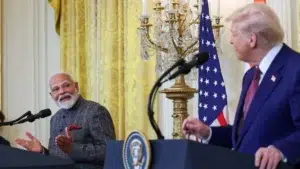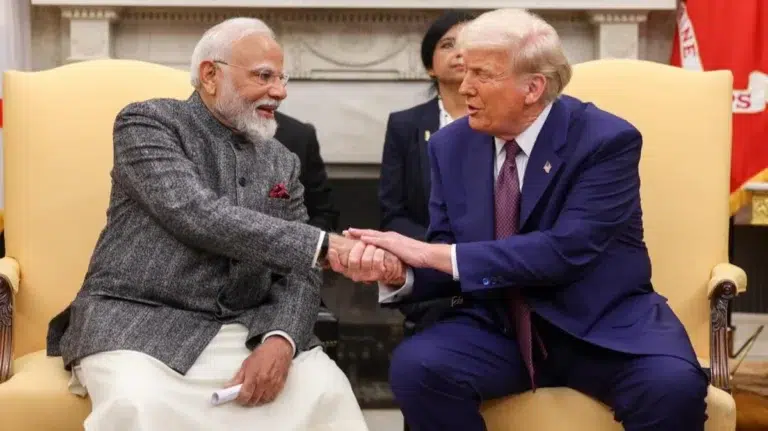India-US Agreements: India and the US on Monday signed several major deals to strengthen bilateral ties. The agreements, which were signed after high-level talks between Prime Minister Narendra Modi and US President Donald Trump, reflect a growing strategic partnership. The deals cover areas such as trade, defence, energy and innovation.
U. S. -India ties reach new heights during Modi visit NEW DELHI (AP) — Prime Minister Narendra Modi’s visit to the United States last week kicked off a new era in the U. S. -India relationship with high-profile deals that could set the course for their partnership for decades. One of the first foreign leaders to meet President Donald Trump in his second term, Modi signaled the growing importance of the U. S. -India alliance, especially as global dynamics change. Discussions on trade, defense, energy and technology reflected a shared vision for a stronger, more collaborative future.
Trade: Navigating Tariffs and Building Bridges
Trade tensions top agenda Trade was top of mind for the presidents during their visit to a country long criticized for tariffs and imbalances. Trump had often slammed India’s high import duties, calling it a ‘tariff king. ’ This time, the message was different. India said it would cut tariffs in electronics, medical equipment and chemicals to boost U. S. exports and ease trade tensions.
Key outcomes include India’s commitment to substantially increase its imports of U.S. energy products, including LNG. This helps to address the U.S. -India trade deficit and also meets India’s goal of diversifying its energy supplies. The leaders also discussed the potential for a mini trade deal by 2025 that would open India’s markets to U.S. agricultural products and reduce tariffs on some goods. Challenges remain, but the visit signaled a willingness on both sides to find common ground and make progress.
Defense: A Growing Military Partnership
Defense cooperation also advanced during Modi’s visit with both countries announcing steps to strengthen military ties and India’s commitment to increase purchases of U. S. made defense equipment. But the big announcement was a potential sale of the F-35 stealth fighter jet to India, which would mark a major step in sharing military technology and joint production.
In addition, the two countries announced a historic deal to co-produce jet engines in India through a partnership between General Electric and Hindustan Aeronautics. This enhances India’s defense capabilities and incorporates cutting-edge U.S. technology into its military. This partnership is also seen as a strategic effort to counterbalance China’s growing influence in the Indo-Pacific, highlighting the geopolitical significance of the U.S. -India alliance.
Energy: Diversifying India’s Energy Landscape

Energy security was also a major theme of the visit. India is one of the world’s biggest energy consumers and wants to reduce its reliance on traditional suppliers like Russia and the Middle East. The visit resulted in commitments for the U. S. to become a top oil and gas supplier to India, changing the country’s energy landscape.
The two sides also explored opportunities for nuclear energy cooperation, including small modular reactors, which can help India meet its ambitious decarbonization targets while ensuring a stable and secure energy supply. The partnership includes energy infrastructure investments, underscoring the two countries’ commitment to a long-term partnership.
Technology: Pioneering Innovation Together
Tech is the new driver of U.S.-India ties During Modi’s visit, the two countries pledged to expand collaboration in advanced fields such as artificial intelligence, semiconductors and quantum computing. Joint ventures could drive innovation, create jobs and set new global standards for tech cooperation.
India will also join U.S. initiatives like the Minerals Security Partnership to secure critical mineral supply chains think smartphones and electric vehicles and expand cybersecurity and space tech cooperation, including India’s entry into the Artemis Accords for space exploration to facilitate satellite communication and other space-related collaborations.
Immigration: Balancing Challenges and Opportunities
Immigration was also on the agenda. Modi and Trump discussed illegal immigration, and India said it will work with the US on managing migrant flows. The issue comes in the wake of recent incidents where Indian deportees faced harsh conditions, underscoring the need for a more humane and structured approach.
But the U.S. did say it would streamline visa processes for Indian professionals, including through the H-1B program. Indian talent is critical to the U.S. tech sector, and by expanding legal channels for skilled workers, both countries aim to foster greater people-to-people ties, critical to the U.S.-India relationship’s long-term success.
India-US Agreements: A Partnership for the Future
PM Modi’s visit to the United States was about more than just diplomacy – it underscored the deepening strategic partnership between our two countries. From trade to defense, energy, and technology, the agreements we signed during this visit could transform the U.S. -India relationship into a pillar of stability and innovation in the Indo-Pacific and beyond.
But in spite of the challenges we face, the visit demonstrated our commitment to find solutions and forge a partnership that benefits both our countries. As the world navigates a more complex geopolitical landscape, the U.S.-India alliance serves as a testament to our cooperation, resilience, and mutual respect.




